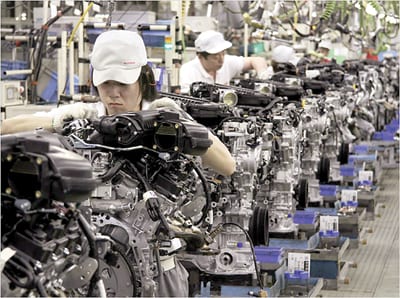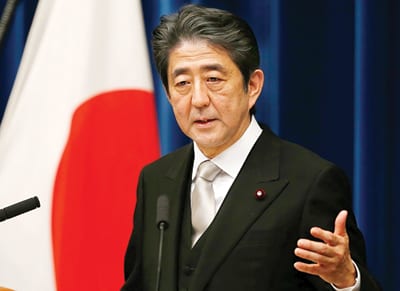Japan’s economy has continued its moderate recovery trend, although exports and production have remained sluggish, due mainly to the effects of the slowdown in emerging economies. The outlook through the 2018 fiscal year envisages that, although sluggishness is expected to remain in exports and production for the time being, domestic demand is likely to follow an upward trend, with a virtuous cycle from income to spending being maintained in both the household and corporate sectors, while exports are expected to increase moderately on the back of emerging economies emerging from their deceleration phase. Thus, Japan’s economy is likely to enjoy a trend of moderate expansion
The year-on-year rate of change in the consumer price index (CPI, all items except fresh food) is likely to remain at around zero per cent for the time being, due to the effects of the decline in energy prices, and then, as the underlying trend in inflation steadily rises, it should accelerate towards two per cent. Meanwhile, assuming that crude oil prices will rise moderately from the recent level, it is likely that the contribution of energy items to the year-on-year rate of change in the CPI will decrease gradually from the current level of slightly more than minus one percentage point, but will remain negative until the beginning of the fiscal year 2017.2.
Based on this assumption, the timing of the year-on-year rate of change in the CPI reaching around two per cent – the price stability target – is projected to occur during fiscal 2017.3,4. As such, the year-on-year rate of change in the CPI is likely to average around two per cent.
Comparing the current projections through the 2017 fiscal year with the previous ones, GDP growth is somewhat lower, influenced mainly by weaker exports that reflect the slowdown in overseas economies. The projected rate of increase in the CPI for the 2016 fiscal year is lower, mainly reflecting downward revisions in projections for GDP growth and wage developments.
As for the conducting of monetary policy, the Central Bank of Japan will continue with “Quantitative and Qualitative Monetary Easing (QQE) with a Negative Interest Rate”, aiming to achieve the price stability target of two per cent, as long as it is necessary to maintain that target in a stable manner. It will examine risks to economic activity and prices, as well as taking additional easing measures in terms of three dimensions – quantity, quality, and interest rate – if that is judged as being necessary for achieving the price stability target.
THE CURRENT SITUATION
Japan’s economy has continued its moderate recovery trend, although exports and production have remained sluggish, due mainly to the effects of the slowdown in emerging economies. Overseas economies have continued to grow at a moderate pace, but the pace of growth has somewhat decelerated, mainly in emerging economies. In this situation, the pick-up in exports halted recently.
 On the domestic demand side, business fixed investment has experienced a moderate increasing trend as corporate profits have been at high levels. Against the backdrop of steady improvement in employment and the income situation, private consumption has been resilient, although some indicators show relatively weak developments.
On the domestic demand side, business fixed investment has experienced a moderate increasing trend as corporate profits have been at high levels. Against the backdrop of steady improvement in employment and the income situation, private consumption has been resilient, although some indicators show relatively weak developments.
Meanwhile, the pick-up in housing investment stopped recently and public investment has been on a moderate declining trend, albeit remaining at a high level. Reflecting these developments in demand, both at home and abroad, industrial production has continued to be more or less flat, while it was most recently hit to an extent by the Kumamoto Earthquake.
As for the conducting of monetary policy, the Central Bank of Japan will continue with “Quantitative and Qualitative Monetary Easing (QQE) with a Negative Interest Rate”, aiming to achieve the price stability target of two per cent, as long as it is necessary to maintain that target in a stable manner
Business sentiment has generally remained at a favourable level but has become cautious, mainly reflecting the slowdown in emerging economies. Financial conditions are highly accommodating. On the price front, the year-on-year rate of change in the CPI (all items except fresh food, and the same hereafter) stands at around zero per cent. Although inflation expectations appear to be rising on the whole from a somewhat longer-term perspective, they have recently weakened.
OUTLOOK FOR ECONOMIC ACTIVITY
Looking ahead, although sluggishness is expected to remain in exports and production for the time being, domestic demand is likely to follow an upward trend, with a virtuous cycle from income to spending being maintained in both the household and corporate sectors, while exports are expected to increase moderately on the back of emerging economies moving out of their deceleration phase. Thus, Japan’s economy is likely to experience a moderate expansion trend.

Against the backdrop of such an outlook, the growth rate during the projection period is expected to be generally above its potential, although fluctuations due to a front-loaded increase and subsequent decline in demand prior to and after the consumption tax hike planned in April 2017 are expected.
The projection above assumes the following underlying developments.
First, as the Bank of Japan continues with “QQE with a Negative Interest Rate”, aiming to achieve the price stability target of two per cent, as long as it is necessary for maintaining that target in a stable manner, financial conditions are likely to remain highly accommodative, with real interest rates being negative throughout the projected period, and continue stimulating the economy.
Second, overseas economies are projected to remain in a state of slight deceleration for the time being, although their growth rates are expected to increase moderately, as it is likely that advanced economies will continue to see firm growth and emerging economies will move out of their deceleration phase on the back of developments in advanced economies.
Looking ahead, although sluggishness is expected to remain in exports and production for the time being, domestic demand is likely to follow an upward trend, with a virtuous cycle from income to spending being maintained in both the household and corporate sectors
Third, public investment has been experiencing a moderate declining trend, but it is expected to gradually level off, mainly reflecting the earlier implementation of the budget for the 2016 fiscal year, and then, from the middle of the projection period, it is likely to remain more or less flat, partly due to increasingly large investment related to the hosting of the Olympic Games.
Fourth, the medium- to long-term growth expectations of firms and households are expected to rise moderately against the backdrop of progress in the implementation of the government’s growth strategy, including regulatory and institutional reforms, an increase in labour participation by women and the elderly under such a strategy, companies continued efforts towards improving productivity and discovering potential domestic and external demand, and steady progress in overcoming deflation.
Given these assumptions, we can elaborate on economic activity during the projection period as follows. In the 2016 fiscal year, exports – despite being likely to continue exhibiting sluggishness for the time being – are expected to head towards a moderate increase thereafter, on the back of emerging economies emerging from their deceleration phase. Corporate profits are expected to maintain their upward trend, especially in the nonmanufacturing sector, and to reach record levels.
In this situation, fixed business investment is projected to continue its uptrend, additionally pushed up by a further decline in real interest rates with the Bank’s monetary easing. Private consumption is projected to rise moderately, led by steady improvement in the employment and income situation, including the continued tightening of labour market conditions and in accordance with the positive effects of energy price declines through the raising of real income.
In addition, in the second half of the fiscal year, the front-loaded increase in demand prior to the consumption tax hike scheduled in April 2017 is likely to push up domestic private demand. Reflecting these developments in demand at home and abroad, the economic growth rate is expected to exceed its potential.
Japan’s potential growth rate is expected to follow a moderate increasing trend throughout the projection period, pushing up the economy’s growth pace in the medium to long term
In the 2017 fiscal year, while household spending is likely to be negatively affected by the front-loaded spending prior to the consumption tax hike, exports are projected to continue increasing moderately, due to economic growth overseas, while fixed business investment is likely to maintain its moderate upward trend, supported by accommodative financial conditions, heightened growth expectations and increases in Olympic Games-related demand. Reflecting these developments, the economy is projected to maintain slightly positive growth, albeit at a level below the potential growth rate.
In the 2018 fiscal year, the growth rate is once again expected to exceed its potential, with exports expected to increase moderately and domestic private demand likely to increase, while the effects of the demand decline after the consumption tax hike will dissipate.
Japan’s potential growth rate is expected to follow a moderate increasing trend throughout the projection period, pushing up the economy’s growth pace in the medium to long term.
Comparing the current projections through the 2017 fiscal year with previous projections, GDP growth is somewhat lower, influenced mainly by weaker exports that reflect the slowdown in overseas economies.